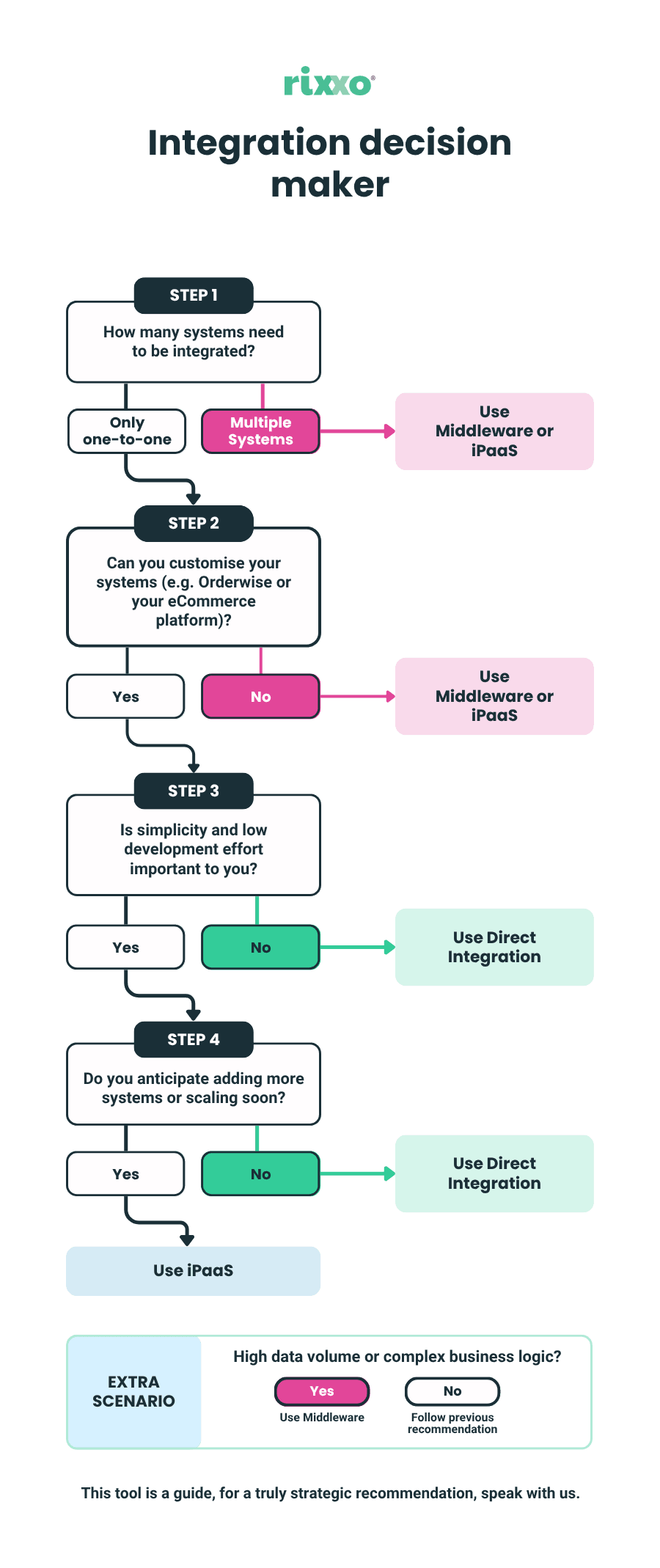What is iPaaS? And do you need it for Orderwise?

Integration confusion is common
If you’ve heard the term “iPaaS” floating around and thought, “What is that?”, you’re not alone. For many businesses using ERP systems like OrderWise, integration can feel like a maze of acronyms, tools, and conflicting advice.
Software integration is a method for connecting and automating the core components of your business. How you do it depends entirely on how your business operates.
This article will explain what iPaaS is, how it works with Orderwise, and whether it’s the right choice for your integration needs.
What is iPaaS?
iPaaS stands for Integration Platform as a Service. It’s a cloud-based solution that helps different business systems talk to each other, without needing to write code from scratch.
Think of it like a universal connector or a digital control panel. With iPaaS, you can build flows between tools like your ERP, eCommerce platform, CRM, and marketing software using pre-built, configurable blocks.
For example:
- One block pulls customer data from your eCommerce store.
- Another cleans and maps the data.
- A final block sends it into Orderwise.
These blocks are tested, maintained, and ready for use, saving time and effort. Even non-developers can work with them, much like using simple logic tools such as Scratch, which is taught to children in school (yes, it’s that intuitive!).
How iPaaS works with an ERP system like Orderwise
Orderwise is a powerful ERP, but it doesn’t natively talk to every other tool you use. That’s where iPaaS steps in.
An iPaaS platform sits between Orderwise and systems like Salesforce, HubSpot, or your e-commerce store. It can:
- Automate data transfers on a schedule (e.g. inventory syncs every 10 minutes).
- Map and transform data to match each system’s format.
- Let you build workflows like “when stock drops below X, notify sales.”
- Provide monitoring tools and alerts when something goes wrong.
- Easily duplicate tasks (e.g. send product updates to five storefronts at once).
The most significant benefit: Speed.
Changes and new connections can be set up fast, without heavy development cycles or major rebuilds.
Do you need iPaaS for Orderwise?
Here’s when iPaaS makes sense:
- You use multiple platforms and want them all connected, fast.
- You can’t (or don’t want to) customise Orderwise or your other tools.
- You want visibility into your data flows without relying on a developer for every tweak.
- You expect to scale and add more tools soon.
It’s especially helpful if you’re working across different platforms (e.g. Magento, Shopify, and Amazon) or need integrations that can evolve quickly with your business.
But, iPaaS isn’t always the best fit. Consider custom or direct integration if:
- You have high data volumes or complex business logic.
- You need very specific triggers or calculations that generic connectors don’t support.
- You want to control every part of the process, and you have development resources available.
Custom integrations often incur higher upfront costs but may ultimately save money in the long term, especially for high-volume operations with stable requirements.
Middleware, a more robust custom integration layer, can handle complex logic, but it also brings higher costs and maintenance responsibilities.
How Rixxo Helps You Choose (and implement) the right path
At Rixxo, we’ve been delivering successful software integrations for a long time. We start every integration project by understanding your goals, systems, and resources. Then we recommend the best-fit integration strategy, whether that’s iPaaS, middleware, or a bespoke solution.
We’re vendor-neutral, meaning we choose tools based on your needs, not on our interests.
We’ve built a simple flowchart to help you work through the key questions and find the right integration approach for your business. It takes you through the factors that matter most, how many systems you’re connecting, whether you can customise them, your timeline, and the complexity of your data flows.
Follow the questions below to get a better sense of direction:


Comparing iPaaS vs custom integration
| Feature | IPaaS | Custom integration |
|---|---|---|
| Speed to deploy | Fast (days/weeks) | Slower(weeks/months) |
| Upfront cost | Lower | Higher |
| Ongoing cost | Monthly subscription | Lower (after initial set up) |
| Flexibility | High (for standard use cases) | Very high (custom everything) |
| Scalability | Easy to expand | Set up dependant |
| User friendly | Yes, visual tools | No, developer only |
| Handles complexity | Somewhat | Fully |
iPaaS is powerful. Whether it’s right for you depends on your setup, goals, and growth plans
iPaaS works well for many Orderwise setups, especially if you need speed and flexibility without heavy development. Custom integrations make more sense when you’re dealing with complex logic or high data volumes.
The right choice depends on your specific situation. Your plaforms, your team, your growth plans. Getting this decision right can turn integration into a competitive advantage.
Ready to figure out which approach fits your business? Let’s talk through your specific setup and find the path that makes sense for you.
